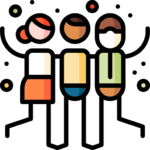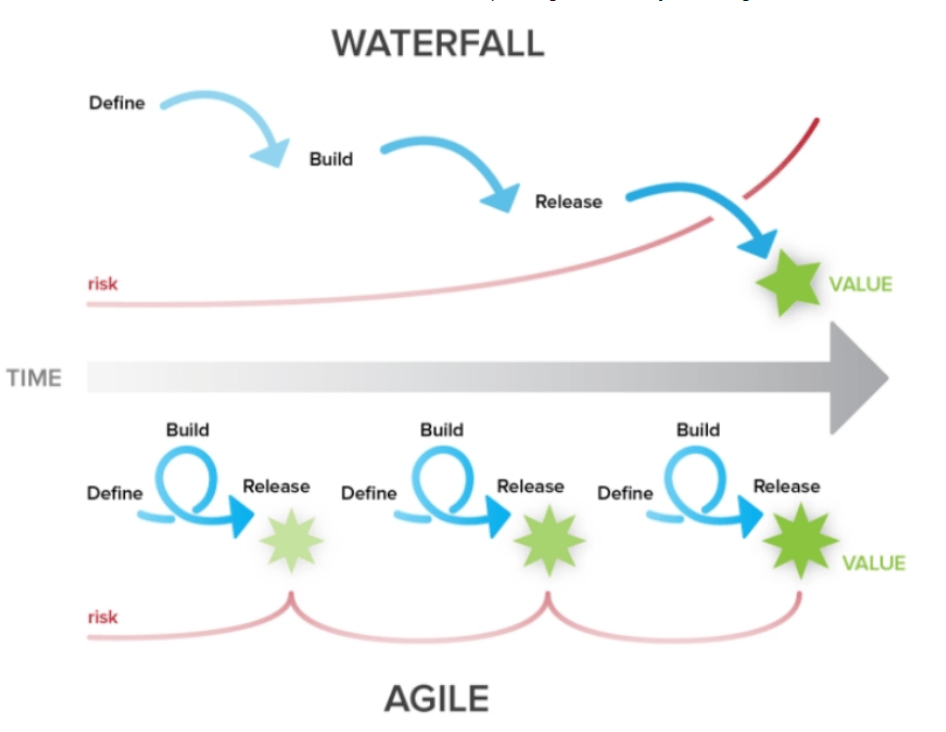PLAY Introduction
When it comes to project management one thing you need to decide first is which methodology to use; Waterfall, Agile or Hybrid?
The one you will select will depend on a lot of things about your project. Until recently the decision was largely between Waterfall or Agile, but a new framework has hit the streets and Hybrid may be the future of project management.
Here’s a breakdown of waterfall, agile and hybrid and why many organizations are using the latter.
PEOPLE
2-3 depending if you are just facilitating or the project manager on the project.
TIME
30-60 Minutes. No one wants to be in a meeting longer than needed. Try to keep it short and sweet.
NINJA LEVEL
Novice to Master. Anyone can facilitate a successful meeting!
PREP WORK
PLACE
Virtually or in-person it is critical that everyone has face-time with each other. So make sure that if attending virtually that everyone can connect in video chat. You will also need to share ideas, so a whiteboard is important and a space that fosters creativity and innovation.
THE PLAY
All of our plays are five steps or less! However, you may need to run multiple plays to get the most out of this one. Don’t worry – you can do it! Learn the play, rehearse it regularly, apply it in the field and debrief on the outcomes. If it worked well, use it again; if it didn’t, find out why. Are there new factors in the system you need to consider, or do you just need to keep practicing? If you need help or have questions on this play, contact us!
01
SET THE STAGE
Who are the players?
Every winning team knows which players to have on the field and what talent you need on the ready. To successfully deploy this play you will need the following roster:
![]() Meeting Facilitator: Likely this is you! But you don’t have to do it alone, ask a friend (think of it like a football team that has a coach for different parts of the team). Skills needed:
Meeting Facilitator: Likely this is you! But you don’t have to do it alone, ask a friend (think of it like a football team that has a coach for different parts of the team). Skills needed:
- Keep the team focused on the goal!
- Foster a positive and creative space for all
- Organized and prepared to run play
![]() Sponsor: This must be someone who has skin in the game. In sports this would be the team owner, someone who has an investment in seeing the team win. In business this is typically a project sponsor or product owner who charters the project. Skills needed:
Sponsor: This must be someone who has skin in the game. In sports this would be the team owner, someone who has an investment in seeing the team win. In business this is typically a project sponsor or product owner who charters the project. Skills needed:
- Authority to fund the project and team
- Engaged in outcomes and supporting the team
- Biggest supporter in the stands
![]() Project Manager: Project managers play the lead role in planning, executing, monitoring, controlling and closing projects. They are accountable for the entire project scope, project team, resources, and the success or failure of the project. Effective project managers need more than technical know-how. The role also requires a number of non-technical skills, and it is these softer skills that often determine whether a project manager — and the project — will be a success. Skills needed:
Project Manager: Project managers play the lead role in planning, executing, monitoring, controlling and closing projects. They are accountable for the entire project scope, project team, resources, and the success or failure of the project. Effective project managers need more than technical know-how. The role also requires a number of non-technical skills, and it is these softer skills that often determine whether a project manager — and the project — will be a success. Skills needed:
- Leadership
- Communication
- Scheduling
- Risk Management
- Cost Management
- Negotiating
- Critical Thinking
- Task Management
- Quality Management
- Sense of Humor
Get the field ready!
![]() Schedule the meeting in advance. Don’t wait until the last minute to schedule the meeting. You want people to be excited about it but not so last minute that they have no time to prepare.
Schedule the meeting in advance. Don’t wait until the last minute to schedule the meeting. You want people to be excited about it but not so last minute that they have no time to prepare.
![]() Include an agenda. Set expectations – this will help keep your meeting on track. Include schedule and any prep work needed. Also let them know if it is okay to invite others or not. Remember that if you have to many people in the meeting, it will be difficult to facilitate brainstorming sessions without breaking out into smaller groups.
Include an agenda. Set expectations – this will help keep your meeting on track. Include schedule and any prep work needed. Also let them know if it is okay to invite others or not. Remember that if you have to many people in the meeting, it will be difficult to facilitate brainstorming sessions without breaking out into smaller groups.
![]() Prep the room. Arrive early and get ready. If it is in a physical room, get whiteboards ready, enough chairs for everyone, water and snacks are always a hit! If virtually, a central location for notes, brainstorms and follow-up items. Test connectivity in the meeting room and make sure there is enough seats for all participants.
Prep the room. Arrive early and get ready. If it is in a physical room, get whiteboards ready, enough chairs for everyone, water and snacks are always a hit! If virtually, a central location for notes, brainstorms and follow-up items. Test connectivity in the meeting room and make sure there is enough seats for all participants.
02
CORE ACTIVITIES
The Great Debate
If you want to have a lively debate ask in a meeting, “What is Agile, Waterfall or Hybrid framework?”. Depending on who you ask you will get answers from a way to sequence work to a full doctorial thesis around the process of operation, business philosophy and a mindset. This play does not aim to answer the question around which is better and why, rather inform you on which to use given your situation and desired outcome.
Let’s start with a shared understanding of each in this context of being a tool you can use.
Waterfall
I know exactly what I want. This is the tool most often used in projects that are contracted initiatives or projects that are repeatable with very little change. Waterfall says we define everything upfront, and then sequentially deliver on that. It is often referred to as “traditional” project management, because this was the go-to for many projects in business pre-2000’s.
Let’s say you are going to go to the dealership and purchase a new car that will cost at least $50k depending on features you select. So you pick out every feature from the seat color to options like cameras and smart driver features. You put your order in and wait for the car to be delivered. This is a perfect waterfall project! You know exactly what you want and you expect it to be as you required.
Waterfall framework is best for:
- When the requirements are very well known, clear and fixed.
- Product definition is stable.
- Technology is understood.
- There are no ambiguous requirements.
- Ample resources with required expertise are available freely.
- The project is short.

Agile
I am unsure of what it is I want and willing to adapt as we go. Meet Agile and it’s fan club. Purest practice the principles in everything they do. Agile is a mindset and there are several practices from it; like the very popular Scrum framework. Agile is about short iterations and pivot. The Agile manifesto provided goals around what agile practices should achieve. Agile has reached celebrity status in the world of project management since the early 2000s and is the tool of choice for most software projects.
Have you ever tried to plan a vacation to a place that you have never been? You may compile a list of highly rated restaurants, top tourist attractions and some dive bars that are the chatter of travel forums. If you were to use an Agile approach, you would not create a day-by-day itinerary or even book your hotel room. You wait until you land at the airport and do a survey of the place. You find a local who can help you get the best hotel and negotiate it with the front desk based on what you decide you need. You wake up in the morning and select your activities based on your list of possibilities. Then that evening over dinner, you reflect on the day and decide if you should change for tomorrow. Maybe you change hotels, restaurants or even locations. That is Agile!
Agile framework is best for:
- When product requirements are uncertain.
- When the client or customer will be available and willing to partake in close collaboration throughout the entirety of the project.
- If the success of your project will be defined by how well the team has satisfied and actively responded to the customer’s developing needs throughout the project’s lifespan.
- When the deliverables of your project can be reasonably distributed in work packets achievable within short time periods of about two to four-weeks.
- If your project involves iterative, or cyclical, processes in which incremental results will add value for your project by continuously providing new guidance for your project.
Hybrid
We know what we want but need some flexibility on it. This is what most organizations use even if they say they are Agile, as it is difficult to be purely one or the other in the real world. The Hybrid approach, as the name implies, is a combination of the Waterfall and Agile methodologies in a flexible yet structured approach that can be used across different projects. The Hybrid methodology focuses on gathering and analyzing requirements initially – a nod to the Waterfall method. From thereon, it takes the flexibility of Agile approach with an emphasis on rapid iterations. By combining attributes of Waterfall and Agile, the Hybrid method (sometimes called “Structured Agile”) gives us the best of both worlds.
Hybrid landscaping is gathering a list of plants you need to buy, going to the store, loading them in the truck and then once you get home assessing the situation. You take all the plants in their containers and set them up in the garden how you thought you wanted them. Then you call over your neighbor and ask their opinion. They suggest different placement and grouping. You make the adjustments and agree it looks better. Then you dig the holes and place the plants. You might go back to the store and get some different plants for the backyard garden, and you repeat the process. You might even do it one more time for the front sidewalk area. That is a hybrid approach.
Hybrid is best suited for aspects of Waterfall and Agile projects in addition to large, complex projects that require that you:
- release new functionality frequently,
- adapt to nontransparent requirements,
- meet strict deadlines,
- take into account that the customer wants to take minimal part in the project.
Waterfall vs Agile
Simplified, waterfall and agile are the same process, just differ on timing. The biggest difference is when the risk is realized. In waterfall you wait until the end to find out if it is good or not, whereas with agile you get this information more quickly at the end of each iteration.
This is why if your requirements are vague, changing or unknown the solution to managing that risk is agile. It is very costly to find out what the requirements are at the end of a project, this is why waterfall is most often used with contract projects. There is a written agreement on the requirements at the beginning of the project.
Hybrid is the Future
Hybrid project management (also called structured Agile) works for every kind of project and every type of team.
Blending Agile and Waterfall makes it easier to adapt throughout your project. Your team works more efficiently, and the outcome is better than it would be if you used just Agile or Waterfall alone.
Hybrid works the way projects are actually run.
Being able to apply Agile to uncertain aspects and Waterfall to fixed deliverables means having a flexible project that’s better built for success.
The beauty of the hybrid project management method is that it lets the team plan before starting to work on the project, but also divides the development cycle into short-term deliveries called sprints. This phase gate approach at the beginning delivers all the benefits of traditional waterfall frameworks, yet the circular iterative implementation approach facilitates the flexibility of Agile.

Overall project responsibility is given to a Project Manager using WBS methodology whereas the sprints are run by Scrum Masters. The PM also assumes the role of the product manager, and is considered the business owner of the project. They are mainly concerned with the front end of the project flow, including requirements, customer feedback, components definition and WBS, while Scrum Masters have a hold on the back end, managing backlogs, sprints and releases. The project manager gathers the scrum masters, who in return form their own teams.
Decide on a Framework
Okay so now it’s time to decide. This should be a decision made before the project kick-off meeting so that the team has a clear understanding of what to expect for the project.
Consider:
- Do you have a clear picture, scope and little stakeholder influence? Waterfall is the way to go.
- If you don’t want to set anything in stone in the beginning? Agile ensures you can switch it up at any time.
- Do you want the best of both worlds? Hybrid is your friend.
But to put it simply; there is no option that fits all especially when it comes to your skill set. So know your options, be prepared for projects, set the time frame and ask yourself plenty of questions!
Here are just a few that might help:
- What is the context of the project?
- Is it set in stone or rather vague?
- Will external stakeholders have an impact?
- Do you have the skill set in your team?
- What’s the time frame?
Make sure you are on the same page with the Project Sponsor and set-up a quick meeting to review and brainstorm together.
Want to learn more about what is a Scrum Master? Check this article from Scrum.org
03
 TEAM HUDDLE
TEAM HUDDLE
Time to run the Team Huddle play. Ask the team the following questions and then take a vote. Keep follow-up questions to a minimum and capture any issues raised as an offline follow-up (and be sure to follow-up).
Understand the play?
![]() The play was understood and I asked any questions in time!
The play was understood and I asked any questions in time!
![]() I’m not sure I understand and I have some questions …
I’m not sure I understand and I have some questions …
![]() I did not understand the play or my part in it.
I did not understand the play or my part in it.
Did you get in the game?
![]() Yes, I made my moves and was in the right place at the right time!
Yes, I made my moves and was in the right place at the right time!
![]() I’m not sure I understand what I was supposed to do …
I’m not sure I understand what I was supposed to do …
![]() I kept the bench warm and watched from the sidelines.
I kept the bench warm and watched from the sidelines.
Ready for what’s next?
![]() Yes, I know the game plan and ready to win!
Yes, I know the game plan and ready to win!
![]() I’m not sure what’s next or if I am involved …
I’m not sure what’s next or if I am involved …
![]() No clue what’s next and would rather sit it out.
No clue what’s next and would rather sit it out.
04
NEXT STEPS
Phew! The hard part is done! You might be tempted to go further and discuss further details of the project – but don’t! Instead thank the Sponsor for a very successful and productive meeting!

![]() Schedule the next meeting where the team will to officially Kick-off the project.
Schedule the next meeting where the team will to officially Kick-off the project.
![]() Publish your notes in a central repository that the team has access to immediately. Even better if it is someplace that the team can add comments or collaborate on. Keep the creative chat going!
Publish your notes in a central repository that the team has access to immediately. Even better if it is someplace that the team can add comments or collaborate on. Keep the creative chat going!
05
IT’S A WRAP
You did it! Now just a few follow-up items:
- Reflect on the play. Ask yourself how it went? What could have gone better, what could have gone worse? In sports this is watching the game again to see any plays that could have been better. Update your playbook. Build feedback loops that help you see what’s working; what’s not; and how to continue to develop the playbook by learning, adapting and iterating constantly as situations change and new challenges arise.
- Contribute to the community of Playbook.Ninja. Sign-up for an account and receive updates on when new plays are added and help others by commenting on the plays with what worked or your experience.
Thank you for being a Playbook.Ninja
![]()



 TEAM HUDDLE
TEAM HUDDLE